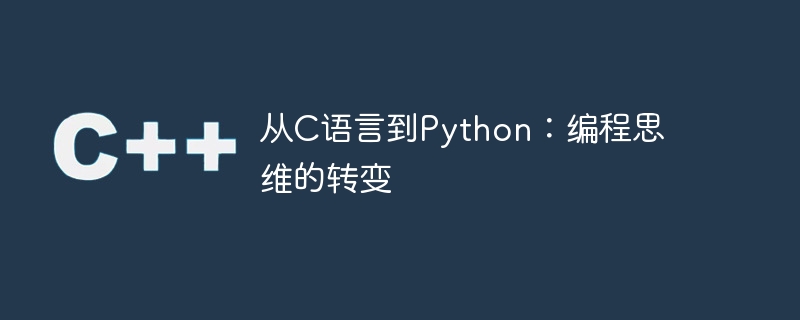Home >Backend Development >C++ >From C language to Python: the change in programming thinking
From C language to Python: the change in programming thinking
- 王林Original
- 2024-03-22 14:21:04886browse

From C language to Python: The change in programming thinking requires specific code examples
In the field of computer programming, the choice of programming language is crucial for developers important. Different programming languages have different grammatical structures, features, and applicable scenarios, so learning and mastering multiple programming languages is very valuable for programmers. This article will focus on the transition from C language to Python, explore the change in programming thinking in this process, and give specific code examples as illustrations.
C language is a relatively low-level programming language. It is a procedural programming language that emphasizes low-level memory management and pointer operations. Different from this, Python is a high-level programming language with concise and easy-to-read syntax, rich standard library and high development efficiency. Therefore, changing from C language to Python often requires programmers to adjust and transform their programming thinking.
In C language, programmers need to manage memory allocation and release by themselves, and use pointers for data operations. The following is a simple C language sample program that implements array traversal and summation operations:
#include <stdio.h>
int main() {
int arr[5] = {1, 2, 3, 4, 5};
int sum = 0;
for (int i = 0; i < 5; i++) {
sum += arr[i];
}
printf("The sum of the array is: %d
", sum);
return 0;
}In the above code, the programmer needs to manually define the size of the array, use a loop to traverse the array elements and sum them . Next, we will show how to use Python to achieve the same function, demonstrating the change in programming thinking from C language to Python.
arr = [1, 2, 3, 4, 5]
total = sum(arr)
print(f"The sum of the array is: {total}")Through this Python code example, we can see that compared to C language, Python has a more concise syntax and higher readability. In Python, we don't need to worry about memory management and data types, we only need to focus on problem solving. Python's advanced data structures and built-in functions allow programmers to focus more on solving the problem itself rather than the details of the programming language.
In addition, Python also has powerful standard library and third-party library support, making development work more efficient. For example, when processing strings, Python provides a rich string operation method, as shown below:
text = "Hello, world!" uppercase_text = text.upper() print(uppercase_text)
By calling the upper() method of the string object, we can Convert a string to uppercase, which in C requires looping through each character of the string.
To sum up, during the transition from C language to Python, programmers need to make adjustments to their programming thinking. Moving from low-level memory management and pointer operations to the use of advanced data structures and built-in functions requires programmers to continuously learn and think in practice. However, Python's concise and easy-to-read syntax, rich library support, and high development efficiency provide programmers with a more convenient and faster development experience, helping them better solve problems and realize creative ideas.
Through the specific code examples shown in this article, we hope to help readers better understand the change in programming thinking from C language to Python. We also hope to inspire readers to think about the differences between different programming languages, so as to better understand the changes in programming thinking from C language to Python. Improve your practical ability in the field of programming.
The above is the detailed content of From C language to Python: the change in programming thinking. For more information, please follow other related articles on the PHP Chinese website!

